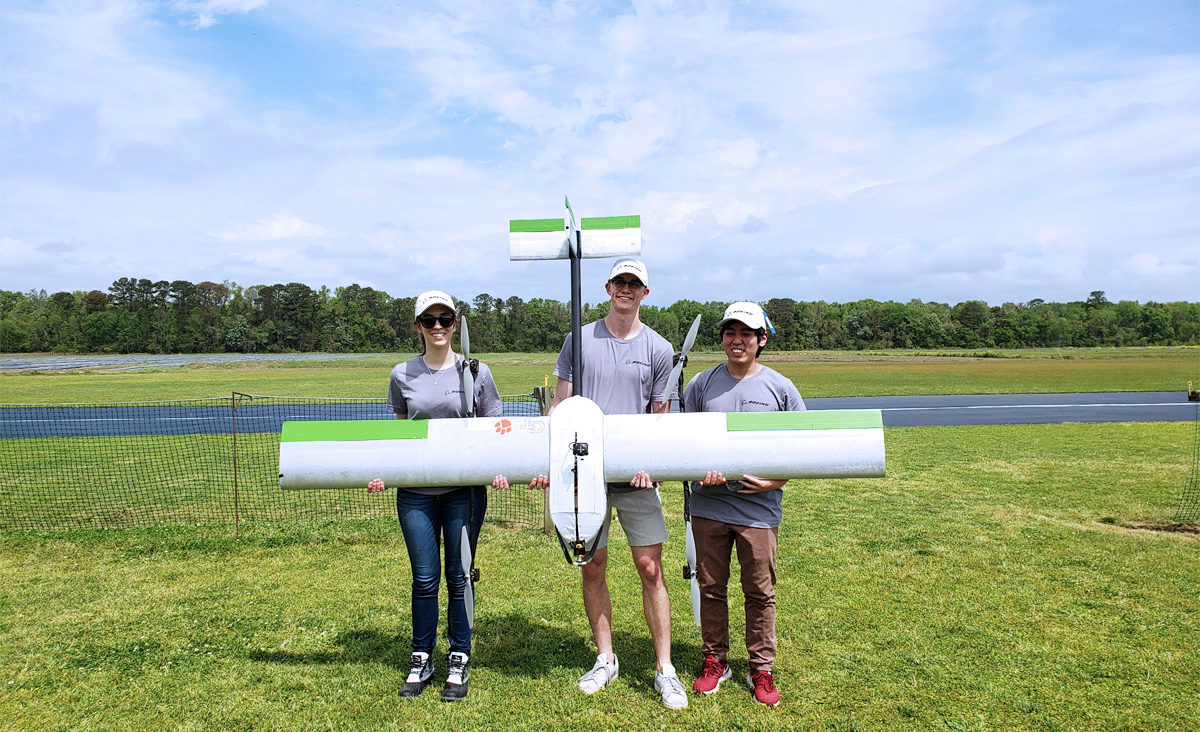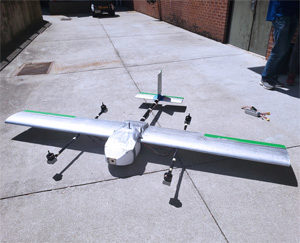
Calm Before the STORM: AE students Alex Miner, Andy Person, and Gen Mark Tanno pose with their award-winning drone, S.T.O.R.M. (Surveillance Technology for Organized Relief Management) in Charleston, SC. For close to 8 months, the trio worked remotely with student engineers from Clemson and Tuskegee universities (not pictured): Tyler Hayward, John Knoblauch, Connor Skelly Aaron Dorsey, Prince Johnson, Julian Thompson, and Mouhamadou Thiam.
 |
| Alex Miner |
For Team STORM, Boeing's 2019 AerosPACE Competition, held April 11 and 12, was nothing but blue skies.
Their drone, (Surveillance Technology for Organized Relief Management) took home the Best 3D Printing, Manufacturing, and Autonomy prize at Boeing's annual match-up, held in Charleston, SC.
Designed, built, and tested by student engineers from AE's Aerospace System Design Laboratory (ASDL), Clemson University, and Tuskegee University, STORM is a fixed-wing unmanned aerial system (UAS) that, according to competition rules, had to cost no more than $6,000 to build and be launchable by hand. Functionally, it had to be capable of helping disaster victims by carrying emergency payloads -- first-aid kits, life straw water filters, and cell phone-enabled GPS trackers -- to remote terrains.
The most challenging part of the competition might have been its location, or lack thereof: for the eight months leading up to the Charleston fly-off, engineers had to communicate, brainstorm, evaluate, and test much of their work from remote locations. Each of the 7 teams competing in the AerosPACE competition was composed of
 |
| Andy Person |
students from three different universities.
"We applaud Team STORM's design, of course, but what gives us deep pride, as engineers, is the team's ability to work remotely, with discipline and precision, for close to eight months," said ASDL director Dimitri Mavris.
"The students got great real-world experience that will teach them how to collaborate across times zones and cultures.”
Teams relied on digital resources -- Webex, Google Hangouts, and Slack -- to communicate, update documents, and hold virtual meetings. They also relied on one old-school resource -- the United States Postal Service - to order and ship parts to and from teammates at other schools.
“It was challenging coordinating with everyone’s schedules, we really had to use the resources Boeing provided for the competition to make sure we stayed up-to-date and on schedule,” said STORM's chief engineer, Alex Miner.
While STORM's internal components and jigs were laser-cut and 3D-printed in Georgia Tech's Yang Aero Maker Space, teammates from Clemson 3D-printed the plastic skin used on the fuselage and printed models for a composite skin made out of glass.
Teammates from Tuskegee 3D printed the housings for the quad motors and solder some of the electrical components of the propulsion system.
For most of the last semester, Team STORM ironed out design flaws that would have otherwise caused the drone to crash. Over spring break, they did a temporary fix: adding a composite and plywood structure to
 |
| Ready to Rescue. The STORM drone had four motors attached to two beams on each wing - a detail that was added to improve hoverability. |
strengthen the tail boom's connection. This allowed them to do a test flight.
“We later replaced it with a permanent fix which involved the tail boom extending through the entire fuselage of the drone,” said Andy Person, STORM's project manager.
The competition also offered teams optional ‘stretch goals’-- additional challenges that touched on areas of interest for Boeing. Team STORM welcomed the chance to sweat another test.
They chose vertical take-off and landing (VTOL) to stretch their skills.
“Forward flight and VTOL are kind of counterintuitive, so we really had our work cut out for us," said Miner. "Adding VTOL capabilities creates different forces acting on the drone and structurally changes the plane."
"Seeing our drone successfully fly during competition was probably the highlight of my time here at Tech."
To view one of STORM's first successful test flights, view the video below.
[VIDEO::https://www.youtube.com/watch?v=TpMFuLRTvXQ]